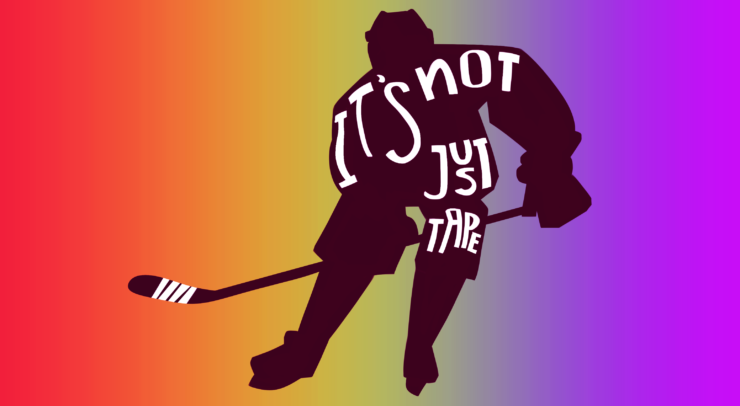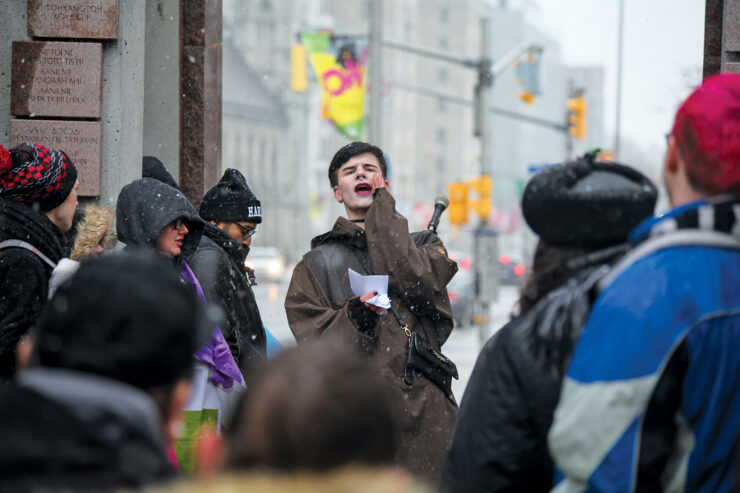Coping with isolation inside and outside of the LGBTQ+ community
Savannah: So when we talk about transmisogyny, how is this a different thing from the kind of misogyny talked about by cis women?
Fae Johnstone: I think when we talk about transmisogyny, what it’s really talking about is misogyny distinct as one experience and transphobia as one experience, and the intersection of those things. So when it comes to transmisogyny, a lot of the times trans women and trans feminine folks are put into this box where they have to walk a very tight line.
So what that means is that trans folks and misogynists will say trans women are upholding gender roles, like these really sexist notions of womanhood, and so trans womens are in this position where they have to either play into that to some extent, but also push back against it. If they display overt femininity they’re told that they’re reinforcing gender roles, and if they display any form of masculinity remotely, they’re told they’re not actually a woman.
And so when it comes to transmisogyny, I think in a lot of ways there are huge similarities with misogyny, right? In terms of like catcalling, harassment, sexual violence, every single thing, but I think because we have this hyper-visibility of transfeminine folks and trans women, there’s a distinct experience within that cis women don’t experience.
S: Do you think that intersection makes it harder for trans folks to call out things like street harassment as not ok?
F: I think the risk of violence can be higher if you do it. I think that depending on the trans woman or trans person in question, if you call somebody out that’s catcalling you … there’s a risk that they will realize that you’re trans, for one thing. And I think that puts you in a really potentially violent and dangerous situation, so there is a risk to calling it out that isn’t present to the same extent when you’re not trans.
S: Do you notice transmisogyny within the LGBTQ+ community?
F: Hugely, I think. When it comes to within LGBTQ+ spaces, again the outside reality that we live in a patriarchal society that vilifies womanhood and femininity still comes into play. And so if we get down to the roots of it, I think people are still afraid of assigned male at birth (AMAB) people who are proud of feminine and woman-aligned identities. I think there’s still a gut reaction that we have a hard time articulating but exists.
Again, definitely most LGBTQ+ spaces and trans spaces as well are dominated by people who aren’t being impacted by transmisogyny. So even when I’ve engaged in trans spaces, most of the time when I go to an event I know there’s going to be a bunch of trans masc(uline) folks and a couple token trans women and trans femmes. And I think that again, there’s a tendency to think about and talk about transness in a way that ignores transmisogyny and the fact that everybody within the trans community experiences transphobia, but the way in which it impacts our existence in this world differs hugely.
I don’t see that acknowledged, despite the fact that so many people will talk about how they support trans women, but I don’t see the tangible efforts within our community locally, as opposed to supporting some trans woman celebrity to make that happen.
S: What kind of impact do you think that dynamic has on trans representation in social movements, or in the media?
F: Even now I have a hard time naming older trans folks that exist in our spaces, and so there’s an intergenerational loss when there isn’t that representation. Because again, any trans person struggles when it comes to existing or coming out as their chosen gender that they are, but I think that transfeminine folks and trans women don’t have those local role models, and so I think representation at the end of the day really does matter.
Again, our discourse around transness is one that has a few hyper visible famous trans women, and everyone can name them. Laverne Cox, Janet Mock, and a few other folks, that are like journalists, or have radio shows … but then every other level of representation around transness focuses on transmisogyny exempted folks. And so I think that has an impact on trans women and transfeminine folks feeling like they can come into trans spaces, and having the role models to help them do that.
S: How do you cope with facing transmisogyny?
F: I get angry about it a lot (laughs). I keep my friend group to people I know I can trust and I know I can trust their politics around transmisogyny, and as much as I can I try to develop relationships with other transfeminine folks and other trans women because I think that is a really powerful and meaningful thing to have shared spaces where we can have shared experiences. We don’t always get that in trans spaces, and there are a lot more broader LBGTQ+ or trans spaces that are not ones that are specific to trans women and transfeminine folks.
S: Do you feel transmisogyny is a factor that may dissuade young people from coming out as trans?
F: Definitely. There are statistics around, I believe trans women tend to come out a lot later in life. And the reason for that I would hypothesize is that a lot of folks need to make sure their lives are in order because of the fact that there’s so much more risk involved. So on one side there is, transmisogyny dictates that trans women are more likely to have negative experiences when they come out. Because again, in a patriarchal context, we have more of a problem, to some extent, with feminine boys than we do with slightly masculine girls.
So like girls can wear jeans, but if a dude shows up to a high school in a dress, I don’t even want to know where that goes. I think that creates a messy cocktail where, since we don’t allow AMAB folks to express themselves in different ways, and we police their expression, again, within a patriarchal context, to such an extent that it’s very difficult for people to come out as transfeminine or as a trans woman.
S: Do you find campuses provide enough formal or informal education around transmisogyny?
F: I think student unions tend to do what they can to some extent. Again, as a Carleton student I haven’t had negative experiences working with the folks at the service centres or the Carleton University Student Association, but again I think it’s hard to address that specific intersection because there are so many interconnected issues to it.
The patriarchy and toxic masculinity play into it hugely, transphobia, and there are so many interconnected issues that unfortunately campuses would have a very hard time knowing how to address. I know that they’ve done a lot of work to create trans spaces like the Pride Centre, and we have the Gender and Sexuality Resource Centre at Carleton, spaces which are blatantly in support of trans women and transfeminine folks.
But it’s again the outside forces of transmisogyny, meaning that there aren’t a lot of trans women they can be reaching out to and supporting. The population of trans women and transfeminine folks in Ottawa that are out and engaging in spaces is very much smaller than that of trans populations more broadly.
S: Do you think the responsibility to combat transmisogyny lies more at an individual level then?
F: It’s privilege and oppression 101, everybody comes into a space with significant amount of privilege and significant amounts of oppression. I fundamentally believe that your responsibility as somebody who exists in these spaces and pushes toward progressive, anti-oppressive goals, is to do the allyship to those communities in which you have a privileged relationship to.
As a white person, if I’m organizing something, I have a very clear responsibility in terms of not being blatantly racist during my organizing, but also being aware of the space that I take up, and all of that jazz, and I want to see those similar kinds of conversations happening within similar, broader trans and LGBTQ+ spaces, as well as feminist spaces.
It is on an individual and community level, but I think also more active support for organization and causes that are by trans women and transfeminine folks is also something that we need more of.
S: How would you define effective allyship, from either within or outside of the LGBTQ+ community?
F: First of all it’s unpacking your own biases, because we live in a society that does teach misogyny and teaches transphobia, and teaches a very unique intersection of those things, so doing the legwork and educating yourself around what that is and what that looks like. A lot of people will say that they support trans women, but it’s like, ok but you still talk and engage in a way that doesn’t.
So even talking about body parts in a way that doesn’t essentialize all women having vaginas, and not all dudes as having penises, that is something that needs to happen. And that supports all trans folks. So in a lot of ways, allyship to trans women and transfeminine folks is allyship to broader trans communities and broader women communities. I think it’s about acknowledging in trans spaces, that if you’re having an event and it’s only trans masc folks involved in running, planning, and delivering that event, that’s a problem.
An easy to unpack example of transmisogyny is the bathroom debate. Because every single piece of conversation on the bathroom isn’t about trans dudes going into men’s washrooms, it’s about the scary predators that are trans women going into women’s washrooms. So I think that paints a very clear picture.
So trans exclusionary radical feminist (TERF) ideas and ideologies are still much more embedded in our feminist and trans spaces. For example, it’s easier for a transmasculine person to access women’s shelters, than it is for trans women. Which, again, I think trans dudes will also often face violence no matter where they go, but not to the same extent that trans women will. So if a trans woman goes into a women’s shelter, there is a good chance she will not be allowed in. But if she goes to a dude’s shelter? That is a nightmare that I don’t even want to touch with a 10-foot pole.
And so I think that the fact that we’re more comfortable with transmasculine folks talking about feminist issues than we are with transfeminine folks talking about feminist issues, is a problem to me. It’s rooted in TERF politics, where it’s this idea that trans dudes in relation to transfeminine folks do have privilege. And yes, that goes hand in hand with transphobia. But we need our trans spaces to unpack and wrestle with that, and we need feminism to unpack and wrestle with that.
Fae Johnstone (she/they) is a public speaker, consultant and community organizer with a background in queer and trans advocacy and education, non-profits, social work and youth mental health. You can learn more about Fae’s work at https://faejohnstone.com/.








